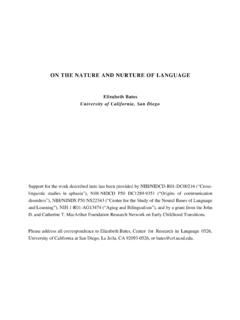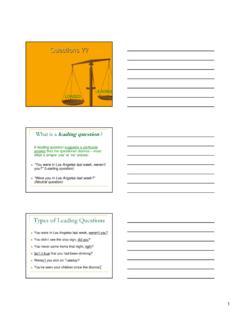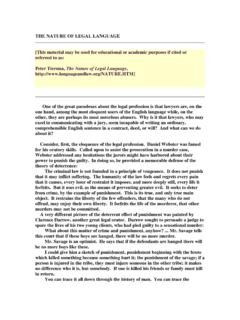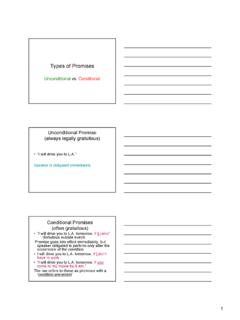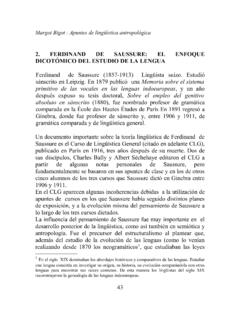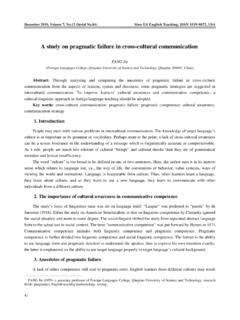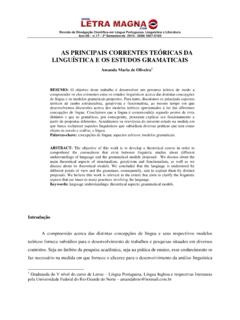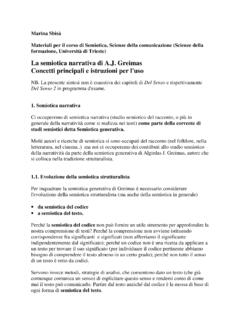Transcription of Introduction to Morphology - University of California, San ...
1 Introduction to MorphologyFarrell Ackerman APM Hours: W or by appointmentHenry Hours: TBA Requirements The final grade will be based on: 7 homework assignments (70%), including attendance in sections where homeworks will be gone over. A take-home final exam (30%) Though it is permitted, even encouraged, to collaborate with others only on the homework assignments, all work must be your own. If you work with others, it is expected that you will list their names in a footnote at the bottom of the 1st page of your assignment and final. This is to acknowledge their input and to permit comparison of their work with your s. Plagiarism is not permitted and University guidelines will be enforced. A important point of the course is to learn how to solve problems, so you miss the point, if you cheat. Goals of the course Introduce the basic methods for analyzing words.
2 Identify the patterns of word shapes and their strategies of formation found cross-linguistically. Develop a typology of these patterns. Develop theories that can account for these patterns. Get insights into the human mind by examining the patterns of Morphology , why they might be like they are, how they are learned, comprehended and produced, and change over time. Syllabus(Chapters from G. Booij The Grammar of Words)Week 1 2 Introduction , basic conceptsChapters 1, 2 & 12 Week 3-4 Derivation & CompoundingChapters 3 & 4 Week 5-6 Inflection & ParadigmsChapters 5 & 6 Week 7-8 InterfacesChapters 7, 8 & 9 Week 9 Morphology & PsycholinguisticsChapter 10 Week 10 Morphology & PsycholinguisticsChapter 11 What is Morphology ?(image from Carroll et. al. 2005:12) Morphology is the study of form: Biology But, form in biology is also associated with function The payoff(image from Carroll et.)
3 Al. 2005:25) Cross species comparison of body design in conjunction with results in molecular genetics and developmental biology are providing new understanding of constraints and variability in living creatures. This is made possible by good description of variety and similarity, formal tools of analysis, and the development of theories in which to formulate is linguistic Morphology ? Morphology is where all linguistic dimensions come together: Morphology is at the conceptual centre of linguistics. This is not because it is the dominant subdiscipline, but because Morphology is the study of word structure, and words are at the interface between phonology, syntax and semantics. (Spencer and Zwicky 1998:1)What is Linguistic Morphology ? Morphology is the study of the systematic patterns exhibited between forms and meanings of words in natural language August Schleicher, 1859 Hungarian: ll `stand fel- ll `stand up fel- ll- t `set something up fel- ll- t- s `installation Morphology Morphology is the study of the systematic covariation in the form and meaning of words.
4 Not: ..the study of the combination of morphemes to form words Not: ..the study of the internal structure of words A conflict in perspectivesMorphology is the study of morphemes and their arrangements in forming words. (Nida 1949:1) Morphology .. is simply a term for that branch of linguistics which is concerned with the forms of words in different uses and constructions. (Matthews 1991:3)Fundamental questions What are morphemes and what motivates the hypothesis that they exist? What patterns do word exhibit in `different uses and constructions? What sorts of theories have been developed to account for these patterns? To what degree do theories reflect typological and methodological biases? Are there morphological universals? If so, how might they arise? If not, what explains tendencies for languages to display similarities? Morphology Ferdinand de saussure (1916) Human language is a system of signs The sign is a relation between form and meaning This relationship is arbitrary The key insight behind Morphology is that complex signs aren t completely arbitrary Words with similar forms tend to have similar meaningsMorphemes as signs Many words are simple, but sometimes they are complex and composed of identifiable smaller pieces.
5 Farmer is a complex word farm+er, because farmer is part of the systematic set: work worker eat eater drive driver farm farmer where -er is a morpheme, a sign, that means one who Vs A words like dormer (a structure that projects out of a house with sloping roof) and sliver aren t complex, because they aren t parts of a set of related words. How about lovelier, sprinkler, and messenger? work is an arbitrary sign (Armenian yerk-el does just as good a job) and -er is an arbitrary sign (Armenian i in yerki does just as good a job). But, words like work-er are motivated, since there is a productive operation which makes every V-er combination predictable in meaning. The allure of reductionism Entities at higher levels of analysis are simply and exhaustively decomposed into entities at lower levels, until we reach the features associated with phonological as units of information(Haspelmath 2002:62) Bulgarian verbal Morphology (From Stump 2001:37)Feature: grammatical attribute such as PERSON,NUMBER, : a specification of an attribute such as 2ND, SINGULAR, : a feature-value pairing such as 2ND PERSON, PAST bundle: a set of grammatical properties such as {2ND PERSON; PAST TENSE; PASSIVE VOICE}Bulgarian verbal Morphology (From Stump 2001:39) The inflected wordforms of 4 LEXEMES.
6 LEXEME: The abstract element common among related elements. Morphosyntactic/Grammatical word: The meaning associated with the lexeme (lexical) and the morphosyntactic properties (grammatical). Wordform: The formal realization or exponence of the grammatical & Paradigmatic(image from Stump 2001:39) Syntagmatic: The linear arrangement of elements (morphotactics) Paradigm: The set of wordforms sharing the same lexeme; The abstracted schema for wordforms sharing the same lexeme; the selection of one wordform excludes the selection of another wordform for the relevant property set. Syncretism: Identity in wordform, but difference in property set. Words in Morphology We can distinguish between notions of word in terms of different level of abstraction. A LEXEME is a dictionary word , an abstract entity, written in SMALL CAPS A word form is a concrete orthographic or phonological entity A morphosyntactic word is a particular combination of morphosyntactic features A paradigm is a set of word forms (or morphosyntactic words) which belong to a particular lexeme A word family is a set of related lexemesThree dimensions of wordhoodLexemeWord formWALK(V)walkwalkswalkingwalkedMorphos yntactic wordWALK(V)+1SG+PRESWALK(V)+INFWALK(V)+3 SG+PRESWALK(N)+SGWALK(N)WALK(N)+PLThe problems with words(following Dixon and Aikhenvald 2002:6) Morphology is about words, but what is a word?
7 A LEXEME and its family of related forms? An orthographic (spelled) unit? An entity defined in terms of grammatical criteria? An entity defined in terms of phonological criteria? An entity defined in terms of syntactic criteria? A famous characterization a word, then, is a free form which does not consist entirely of (two or more) lesser free forms; in brief, it is a minimum free form. Bloomfield 1933:178 A word is a minimal free form: an entity which can appear as an independent syntactic element which must consist minimally of a LEXEME, ,, it cannot consist simply of affixes, which are never free , weav-er-s is a word, but er-s is problems with words Morphology is about words, but what is a word? Orthographic word Naive definition - sequences of letters separated by spaces Problematic for written languagesused tohors d oeuvrethe mayor of San Diego s house Meaningless for unwritten languages; since words run together in speech, do non-literate peoples have intuitions about words?
8 Of course, how can you learn a language, if you can t identify words and the principles that alter their shapes? Morphological versus phonological words There are mismatches between the phonological word and the morphological word. The basic analytic constructs for these dimensions are different, , foot and syllable for phonology & lexical category and affix for v. Phonology (G bor Bereczki 1981:26)Hungarian: Ez az ember itt l lkod-ik this the person here `this person is loitering here /e za zem be rit t l l ko dik/ Finnish: Minu-n is -ni hampaa-t ova-t ehj -t tooth-PL `my father s teeth are in good shape /mi nu ni s ni ham paa to va te j t/ Estonian: Mu-l on uus auto is new car `I have a new car /mu lon nuu sau to/ Phonological word(Dixon & Aikhenvald 2002.)
9 13) A phonological word is a phonological unit larger than a syllable (in some languages it may be minimally just one syllable) which has at least one (and generally more than one) phonological defining property chosen from one of the following areas:Segmental features - internal syllabic and segmental Prosodic features - stress ( or accent) and/or tone rules - some rules only apply within a phonological Domain of phonological rules/processes English nouns are generally stressed on the first syllable: nvil t lephone Phrase Compound wh te h use wh te house h t d g h t dog But: c rrot cake versus apple p e Phonological words Finnish vowel harmony (front=/y, , /, back=/a, o, u/) Back harmony Front harmony puku dress kyky ability talo house s l splinter kunto condition kynt plowing talo-na house-ESS kyl -n village-ESS But, p -kaupunki capitol city is two words, a compound, for harmony, yet one word for stress assignment, since the stress in on the 1st syllable of the first word, as it is in all Finnish words(Spencer 1991:360) Macedonian words have antepenultimate (3rd to the last) stress, if they have two or more na ta 1b.
10 En ta ti wife ART wife ART your `the wife `your wife Negative marker leads to stress change:2a. mu go d dov 2b. ne mu g dade not `I gave it to him `He didn t give it to him Phonological words(Spencer 1991:360) Phrases versus compounds: Syntactic phrase Compound1a. p va v er 1b. p v ve erSome standard criteria for wordhood Syntactic words: syntax treats some elements as atomic/indivisible, as if their internal structure is opaque to word external operations. Lexical integrity: syntactic operations cannot separate pieces of words walked very slowly * walked slow-very-ly Anaphoric islands: independent syntactic elements cannot peek into words.
